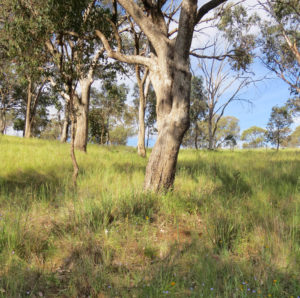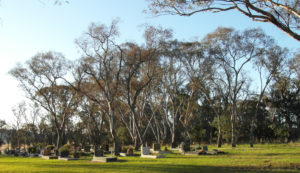Grassy Woodlands
In this case study our intention was to start to develop an approach to operationalising the values-rules-knowledge framework. To do this, we used an example of a landscape that contains a diversity of different biophysical systems, and embodies a broad range of uses, values, and perspectives related to them. We considered that contrasts between cropping/grazing systems and conservation uses would provide a useful basis for assessing a range of possible options and decisions for adaptation to climate change.
We therefore developed biophysical adaptation pathways for temperate grassy eucalypt woodland landscapes of the wheat-sheep zone of south-eastern Australia, which are expected to become warmer and drier under climate change. We used the vrk framework to identify potential constraints to implementing steps in the pathways.

Trees of different ages interspersed with shrubs and a diverse ground cover of grasses and forbs indicate grassy woodland of high conservation value (photo: Suzanne Prober)
Drawing on expert knowledge, published literature, biodiversity modelling and stakeholder workshops we identified potential adaptation pathways for (1) the cropping/grazing production matrix, (2) high conservation value remnant vegetation, and (3) woodland trees in the study landscapes. The pathways involved likely shifts from mixed cropping and grazing towards rangeland grazing or biomass enterprises; promoting re-assembly of native ecological communities with locally and regionally native species and provenances, and maintaining the ecosystem services and habitat that trees provide through a range of approaches.
Across all pathways, applying the vrk framework elucidated twelve key constraints to effective implementation, ranging from farm viability constraints and changing effectiveness of threatened ecological community legislation, to conflicting values about exotic plants. Six of the constraints involved two or three way interactions among values, rules and knowledge; ten involved rules, seven involved values, and only four involved lack of knowledge. Constraints underpinned by values appeared to be the most difficult to address, whereas those underpinned by rule- or knowledge-based challenges were often more tangible.

Grassy woodlands have high cultural, spiritual and sense-of-place values. Hall Cemetery, Australian Capital Territory (photo: Matt Colloff)
We concluded that the values-rules-knowledge approach is helpful to connect the biophysical knowledge-based view of adaptation, and a perspective focusing on adjustments in social systems, enabling recognition and targeting of constraints to adaptation. Our focus on pathways and decision points in different sectors of the multi-use landscape also highlighted the importance of higher-level policy and planning for balancing the collective outcomes of multiple decisions by many land managers.
For more information:
Prober, S.M., Colloff, M.J., Abel, N., Crimp, S., Doherty, M.D., Dunlop, M., Eldridge, D.J., Gorddard, R., Lavorel, S., Metcalfe, D.J., Murphy, H.T., Ryan, P. and Williams, K.J. (2017) Informing climate adaptation pathways in multi-use woodland landscapes using the values-rules-knowledge framework. Agriculture, Ecosystems and Environment 241, 39–53. http://dx.doi.org/10.1016/j.agee.2017.02.021
